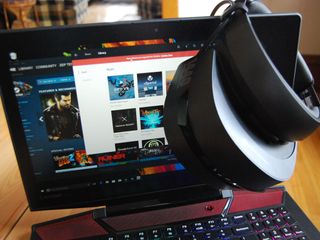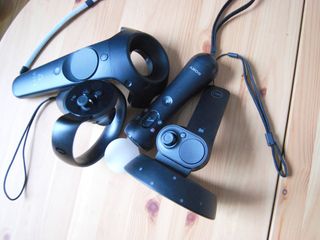
Windows Mixed Reality (WMR) has been available for awhile now, and it's proven itself as a cheaper alternative to Rift and Vive that can nevertheless deliver a similar experience. If you're thinking about getting into VR and you're considering WMR, I've put together this list of five reasons to buy a headset and a couple reasons you might want to pass in lieu of the other PC-based VR systems.
Reasons to buy Windows Mixed Reality
There are a lot of solid reasons to invest in the WMR ecosystem.
Windows Mixed Reality is available at a cheaper price

Depending on which headset you choose to checkout with, you can get started in VR for a lot cheaper than with an HTC Vive or Oculus Rift. Headsets made by HP, Acer, Dell, and Lenovo are regularly discounted, and chances are you should be able to find a headset and motion controller bundle for a price between $200 and $250.
Compared to the $400 price of a Rift with Touch controllers or the $500 price of a full Vive setup, those with a limited budget can nevertheless experience a quality VR experience.
Windows Mixed Reality headsets have a higher resolution

WMR headsets all have a higher resolution display than the Oculus Rift and HTC Vive. In the case of all but Samsung's headset, you're looking at 1,440 x 1,440 per eye, whereas the Rift and Vive are set at 1,080 x 1,200 per eye. Samsung's headset has an even higher resolution at 1,440 x 1,600 per eye, which is on par with HTC's new Vive Pro.
Get the Windows Central Newsletter
All the latest news, reviews, and guides for Windows and Xbox diehards.
What does this mean? In most cases, the image is clearer, making it easier to see small details. Reading text isn't as difficult, and you'll notice an all-around crispness when comparing WMR to the Rift and Vive.
As for field-of-view (FOV), both the Rift and Vive sit at about 110 degrees. Again, WMR headsets differ, with Dell and Samsung offering up the same 110 degrees. Lenovo's headset sits at about 105 degrees, and the rest are at about 95 degrees. If you want to have the least amount of tunnel vision, you'll want to stick with either the Dell or Samsung headset.
Windows Mixed Reality has SteamVR integration

Alongside the VR games and experiences available from the Microsoft Store, SteamVR integration has also opened up the enormous Steam library of games to WMR. Though not all games available from Steam have the official WMR symbol, every one that we've tested has worked across platforms.
If a SteamVR game or experience doesn't have the official WMR logo, your best bet is to do a bit of digging before purchasing to ensure the game works properly. You can always ask in our VR forum!
- How to use SteamVR with Windows Mixed Reality
- How to tell with SteamVR games support Windows Mixed Reality
Windows Mixed Reality is much easier to set up

Whereas the Vive and Rift both have external sensors that must be connected to your PC and set up before playing, WMR is essentially a plug-and-play VR experience. You connect the headset and controllers, and from there you're free to enter VR without having to worry about external accessories. If you're moving around often or like to switch between VR systems, not having to set up external sensors and run through room setup can be especially convenient.
Windows Mixed Reality offers a room-scale VR experience

Considering WMR doesn't use external sensors, you might be wondering how well it fares in a room-scale setup. Fear not, it's nearly on par with what the Rift and Vive have to offer. The headset — and your virtual body inside the experience — does a great job of keeping track of your position, and even if it's not quite the same as with the Rift or Vive, it certainly does an excellent job.
Physically moving around your VR space translates well in-game, and your motion controllers do, for the most part, keep up.
Reasons not to buy Windows Mixed Reality
If you're interested in getting into VR, there are a couple of reasons why you might want to pass on WMR and check out the other PC-based VR systems instead.
Windows Mixed Reality motion controllers don't quite track as well

Yes, the WMR motion controllers work as intended most of the time, but they're actually tracked by two cameras in the front of the headset rather than by any external sensors. This means that moving the controllers out of your view also moves them out of view of the built-in sensors, and tracking can get a bit wonky in this case.
Likewise, attempting to play games that require quick precision movements — like Beat Saber — in a room flooded with sunlight will no doubt cause problems due to the tracking system. If you want the absolute best tracking experience, it stills comes down to the Vive's wands or the Rift's Touch controllers. Not only are they tracked more accurately thanks to external sensors, they're also more comfortable and seem a lot sturdier.
How Windows Mixed Reality motion controllers compare to the competition
Windows Mixed Reality doesn't yet have wireless support

Though official wireless solutions for Rift or Vive have yet to see the light of day, TPCast has stepped in and created third-party options. They're not cheap — the Vive version costs about $280 and the Rift version about $320 — but they remove the need for cables from your PC to the headset.
TPCast did announce that it plans to release hardware support for WMR, but there's still no sign of an official release date. If you're looking for a premium PC-based VR experience that can run wirelessly, you'll want to check out the HTC Vive or Oculus Rift and their TPCast accessories.
Bottom line
There's no denying that WMR can hold its own with the Rift and Vive heavyweights. It's quick and easy to set up, SteamVR integration opens up a ton of games and experiences, and the headsets are, for the most part, cheaper. If you're looking for external tracking or wireless VR, though, you'll still want to check out the Oculus Rift or HTC Vive.

Cale Hunt brings to Windows Central more than eight years of experience writing about laptops, PCs, accessories, games, and beyond. If it runs Windows or in some way complements the hardware, there’s a good chance he knows about it, has written about it, or is already busy testing it.
